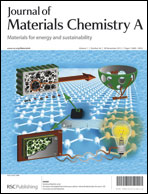Emulsion-templated bicontinuous carbon network electrodes for use in 3D microstructured batteries†
Abstract
High surface area carbon foams were prepared and characterized for use in 3D structured batteries. Two potential applications exist for these foams: firstly as an anode and secondly as a current collector support for electrode materials. The preparation of the carbon foams by pyrolysis of a high internal phase emulsion polymer (polyHIPE) resulted in structures with cage sizes of ∼25 μm and a surface area enhancement per geometric area of approximately 90 times, close to the optimal configuration for a 3D microstructured battery support. The structure was probed using XPS, SEM, BET, XRD and Raman techniques; revealing that the foams were composed of a disordered carbon with a pore size in the <100 nm range resulting in a BET measured surface area of 433 m2 g−1. A reversible capacity exceeding 3.5 mA h cm−2 at a current density of 0.37 mA cm−2 was achieved. SEM images of the foams after 50 cycles showed that the structure suffered no degradation. Furthermore, the foams were tested as a current collector by depositing a layer of polyaniline cathode over their surface. High footprint area capacities of 500 μA h cm−2 were seen in the voltage range 3.8 to 2.5 V vs. Li and a reasonable rate performance was observed.


 Please wait while we load your content...
Please wait while we load your content...